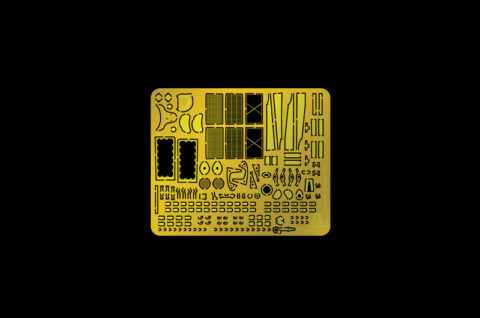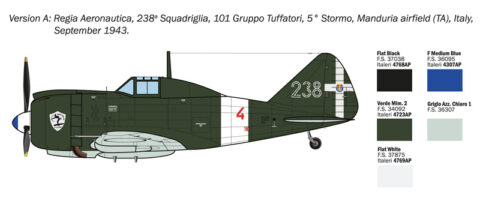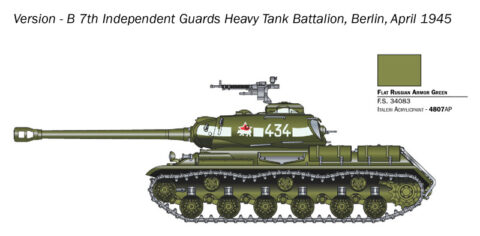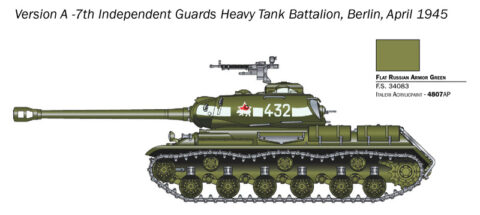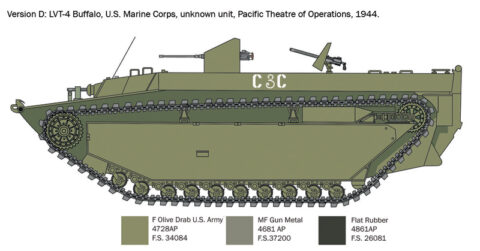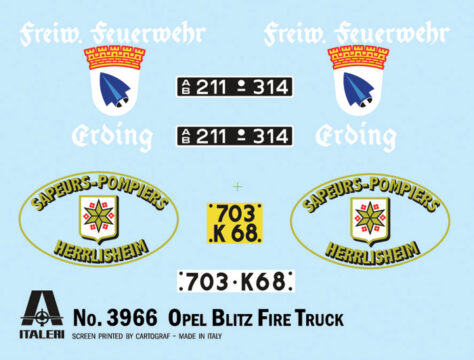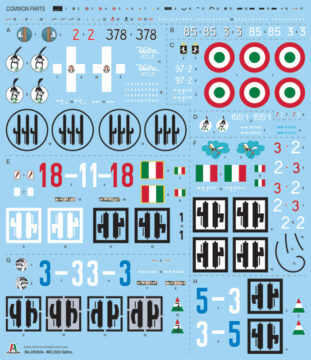Industry News
Italeri News Sep 2024

1/32 Macchi MC.205 Veltro
UPGRADED MOULDS
Super-detailed cockpit with 3D decals – Canopy and wheels masking sheet – Finely detailed engine and nose gun bay – Detailed landing gear with optionals wells covers – PE parts for engine, flaps, cockpit and overall detailing – Realistic panel lines and rivets – Moveable wings and tail ailerons – Open or closed flaps – Super decals sheet for 8 versions – Realistic smoke rings decals with application guide – Colored painting and decals guide
FIGURE NOT INCLUDED
The Macchi M.C. 205 Veltro is considered the best Italian fighter of World War II. The evolution of the “Folgore” retained the excellent aeronautical design of its predecessor and was equipped, like other fighters of the “Series 5”, with the German Daimler-Benz DB605 engine. The powerful V12 engine, also produced under license by Fiat, allowed the Veltro to reach a maximum speed of 640 km/h. Fast, maneuverable, and well-armed, with 2 × 12.7 mm machine guns in the nose and 2 × 20 mm cannons in the wings, it was capable of fighting on par with the best Allied fighters of the period, such as the American P-51 Mustang. It entered service with the Regia Aeronautica in the early months of 1943. After the armistice of September 8, it was used, until the end of the conflict, by both the flight units of the Italian Social Republic and those of the Co-Belligerent Air Force.

1/24 OPEL BLITZ FIRE TRUCK
RUBBER TYRES – COMPLETE FIRE-FIGHTING EQUIPMENT – COLORS INSTRUCTION SHEET
The Opel Blitz project was set up with the aim of mass producing a robust and reliable commercial vehicle that could be used for different applications and tasks. Opel began production of the early trucks, based on a typically US “layout”, in its Rüsselsheim plant in the early 1930s. This was a success story that evolved over time and continued until the mid-1970s. The Opel Blitz’s sturdy structural characteristics were noted by the Wehrmacht and subsequently deployed by them during the Second World War, in both the 4×2 and 4×4 versions. However, its wartime role was later to be eclipsed by its the great commercial success as a civilian vehicle. During the post-war reconstruction period the Opel Blitz was indispensable to Germany’s recovery, being used by merchants, craftsmen, industrialists and many others to rebuild the country. Numerous outfitted versions were also made, including the fire-fighting one.
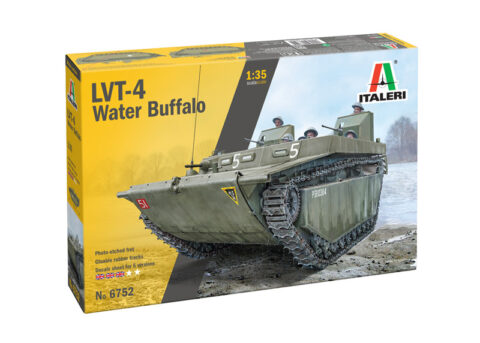
1/35 LVT-4 Water Buffalo (ETO)
GLUABLE RUBBER TRACKS – PHOTO-ETCHED – DECALS FOR 5 VERSIONS
FIGURE NOT INCLUDED
The L.V.T. tracked vehicles (an acronym for Landing Vehicle Tracked) were developed to equip the United States armed forces, including the Army and the Marine Corps, with a suitable vehicle for amphibious operations capable of providing a good level of protection. Often known as “Amtrac,” they were widely used in the Pacific theater against Japanese forces, as well as in the European theater during the last year of the war. The LVT-4, in particular, represented a significant improvement over previous versions. With the redesign, the engine was relocated to a central position, freeing up the rear of the vehicle for the addition of a ramp that allowed for the rapid loading and unloading of light vehicles or small-caliber artillery pieces to support landing troops. It was the most successful version with the highest number of vehicles produced.

1/56 Pz. kpfw. VI Tiger I Ausf. E
WWll TANK COLLECTION – 50 PARTS – HIGHLY DETALIED KIT – TURRET AND HULL WITH ZIMMERIT – DECALS FOR 2 VERSIONS – FIGURE INCLUDED
The Panzerkampfwagen VI Tiger I is undoubtedly one of the most famous tanks of World War II. It was developed to provide the armored divisions of the Wehrmacht with a heavily armored and heavily armed tank to complement the more common medium tanks, Panzer III and Panzer IV, which were no longer effectively countering enemy tanks. Its primary armament consisted of the renowned and lethal long-barreled 88mm KwK 36 L/56 anti-tank gun. Installed in the turret and protected by a heavy 120mm shielding, it could penetrate the armor of any contemporary enemy vehicle even at long distances. Deployed on all major theatres of operation, it played an active role in German military operations in Normandy and the Western Front. Despite facing issues of reliability and deployment, the heavy tank, when operated by skilled crews, was always greatly feared by the Allied forces.

1/56 JS2 STALIN
WWll TANK COLLECTION – 77 PARTS – HIGHLY DETALIED KIT – DECALS FOR 5 VERSIONS – FIGURE INCLUDED
In February 1943, to replace the now outdated KV tanks, the first prototype models of heavy tanks intended to equip the armored units of the Red Army were produced. The most notable of the tanks developed to counter the new and heavily armored German vehicles, such as the Tiger and the Panther, was the Joseph Stalin JS-2. Armed with the powerful 122 mm cannon installed in a centrally mounted turret, it was characterized by a cast steel hull, heavy armor, and the adoption of a 12-cylinder diesel engine with over 600 HP. The overall weight of the tank was 46 tons. It was employed in the battles that led to the recapture of Ukraine, operational activities in Hungary, and, in the final phase of the conflict, during the Battle of Berlin. It was one of the most powerful tanks used by the Soviet Union during World War II.

1/72 Reggiane Re.2002 Ariete
SUPER DECALS FOR 4 VERSIONS – COLOR INSTUCTION SHEET
FIGURE NOT INCLUDED
The Reggiane Re 2002 “Ariete” was developed to provide the Regia Aeronautica with a more modern and effective ground attack aircraft. Based on the airframe of the Reggiane Re 2000 fighter, the aircraft was equipped with a higher-performance engine than its predecessor and featured enhanced armament. In addition to the two machine guns mounted in the nose, two more machine guns were added in the wings, and the aircraft was capable of carrying an offensive bomb load of up to 500 kg. The flight units equipped with the Re 2002 were deployed by the Regia Aeronautica to counter the Allied invasion of Sicily in 1943 and, following Italy’s armistice in September of the same year, were also used by the German Luftwaffe.

1/72 Pz. Kpfw. V PANTHER Ausf. A Sd. Kfz. 171
DECALS FOR 5 VERSIONS – LINK-AND-LENGTH TRACKS – COLORS INSTRUCTION SHEET
CONTAINS 1 FIGURE
The Panzerkampfwagen V “Panther” is widely recognised as one of the best tanks that was produced during World War 2. It was deployed as a direct response to the Soviet T-34 and KV-1 tanks on the Eastern Front, which were superior to both the Panzer III and Panzer IV in terms of performance and armaments. Powered by a 700 horsepower V-12 Mayback engine, it was armed with the 75 mm KwK 42 high speed gun which was a very effective anti-tank weapon. The Panther was designed with optimal armor protection, including inclined front armor. Its overall mobility, speed and armaments made the Panther one of the leading tanks of the period, and ensured its deployment on all of the main operational fronts, from the East through Italy and France.
HobbyLink International
eBay Store


